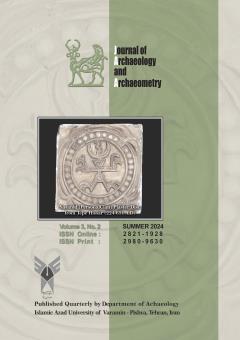Investigating the History of Making Islamic Glass in the 5th and 6th Centuries of the Islamic Era
Subject Areas : ArchaeologyHamidreza Mallahi 1 , Haeideh Khamseh 2 * , Samad Nejad Ebrahimi 3
1 - Islamic Azad University Science Research Branch
2 - Department of Archaeology, Science and Research Branch, Islamic Azad University, Tehran, Iran
3 - Department of Phytochemistry, Research Institute of Medicinal Plants and Raw Materials, Shahid Beheshti University, Tehran, Iran
Keywords: Islamic, Glass Making, History, Iran,
Abstract :
In the 5th and 6th centuries A.H., glassmaking in the Islamic era reached its peak of growth and prosperity in Islamic lands and was accompanied by innovations in the field of construction and decoration, which became the inspiration for glassmaking in the world after this period. This article aims to introduce and categorize innovations in the methods of producing and decorating glass products from the fifth and sixth centuries of Hijra. This research is descriptive-analytical with a library method. The results show in the 5th and 6th centuries of Hijri, Islamic glassmaking underwent significant transformation and innovation, evident in four key areas: color and raw materials, form and manufacturing methods, decorations, and applications. Islamic glassmaking in Iran, Iraq, Syria, and Egypt exhibited distinct technical features compared to the preceding era, which in Iran ceased with the Mongol invasion in the 7th century AH, subsequently shifting to the glassmaking centers of Iraq, Syria, and Egypt.
Akbarzadeh Kurd,A., Mehini, He. 1997. Glass of Marz Bazargan Collection, Tehran, Publications of the National Museum of Iran, Freire W., 1374 Iranian Arts, translated by Parviz Marzban, Tehran.
Alkhemir, S. 2014. Light in art and science from the Islamic world, USA: Focus-Abengoa foundation.
Antonaras, A.C., 2018. A special group of early Christian glass ‘gems’ from Greece. Things that Travelled, p.1.
Antonaras, A.C., 2023. East of the Theater: Glassware and Glass Production.
Carboni, S. 2001. Glass from Islamic Lands. London: Thames and Hudson.
Carboni, S., Whitehouse.D, 2001. Glass of the Sultans. New York: The Metropolitan Museum of Art.
Carboni, Stefano, Marta Drexler lynn, Sidney Goldstein, Sandra Knudsen, and Jutta Page. 2006 . The Art of Glass. London: Toledo museum of art.
Charleston, R.J. and Fisher, J.E., 1990. Masterpieces of glass: a world history from the Corning Museum of Glass. New York: Harry N. Abrams, incorporated.
Davison, S. and Newton, R.G., 2008. Conservation and restoration of glass. Routledge
Davison, L., Horie, Y. and Sekine, T. eds., 2012. High-pressure shock compression of solids V: shock chemistry with applications to meteorite impacts. Springer Science & Business Media.
Dimand, M.E., 2003. Guide to Islamic industries. Translated by Abdullah Faryar, Tehran, Scientific and Cultural Publishing Company. [In Persian].
Emami, MA., Pakgohar s.,2017, Glass Wires of Chogha Zanbil; The First Signs of Glass Making in Iran in the Second Millennium BC. Sh. 5:1-15. Doi:10.29252/jra.3.1.1
Glock, G, Hiramoto, S.,2010, Passages in Iranian Handicrafts, Tehran: National Bank Publications. [Persian]
Goldstein, S. M. 2007., Glassworks, Islamic Art Collection. Trans: Soodabeh Rafiei and Gholam Hossein Mazandarani. Tehran: Karang. [In Persian].
Jenkins, M., 1986. Islamic Glass. A Brief History from Metropolitan Museum of Art Bulletin: 1-56.
Fukaei, Sh., 1996., Iranian Glass, translated by Arman Shishegar, Tehran: Cultural Heritage Publications.[In Persian].
Kruger, J., 1995. Nishapur: glass of the early Islamic period. Metropolitan Museum of Art.
Kruger, F.J. and Bigalke, R.C., 1984. Fire in fynbos. In Ecological effects of fire in South African ecosystems (pp. 67-114). Berlin, Heidelberg: Springer Berlin Heidelberg.
Lamm, C. J. 1931. Les Verres Trouvés à Suse. Syria 12, 358–367.
Madison, F., Smith.E.S., 2007, Scientific tools, translated by Gholam Hossein Ali Mazandarani. Tehran: Karang Publishing.[In Persian].
Mirhadi,B, 2002 , Culture, theory, and technology of ceramic, glass, building materials, Tehran.
Oppenheim, A.L., 1973. Towards a history of glass in the ancient Near East. Journal of the American Oriental Society, pp.259-266.
Page, J.A. and Carboni, S., 2006. The art of glass: Toledo Museum of Art. Giles.
Qobadiani, N.Kh.,1997., Nasser Khosro's travel book. Translated by Nader Vazinpour, Tehran, Scientific and Cultural Publications. [In Persian].
Rahmat Abadi, A., Jalili. M.,,2012,., Glassmaking in Shām during Fourth/Tenth to Sixth/Twelfth Centuries, Journal of History and Culture, VOL 43, (2), 69-88 .DOI: 10.22067/HISTORY.V0I0.12403
Ricke, H., 2002. Glass art: reflecting the centuries.Masterpieces from the Glasmuseum Hentrich in Museum Kunst Palast, Dusseldorf, Munich and New York: Prestel.
Schlick-Nolte, B. and Werthmann, R., 2003. Glass vessels from the burial of Nesikhons. Journal of Glass Studies, pp.11-34.
Shishegar, A.,2002, The Industry of Making Water Bottles in The Seljuk Period and Introducing Some Examples of it. the museum quarterly. Vol. 37: 24-29.
Tait, H., 2012. 5000 years of glass. London: The British Museum.
Whitehouse, D., 2010. Islamic Glasses in The Corning Museum of Glass USA: Corning Museum of Glass
Zaki Mohammad, H., 2002, Fatimid Treasures translated by Neda Golijani Moghadam, Tehran, Al-Zahra University Publications. [In Persian]

